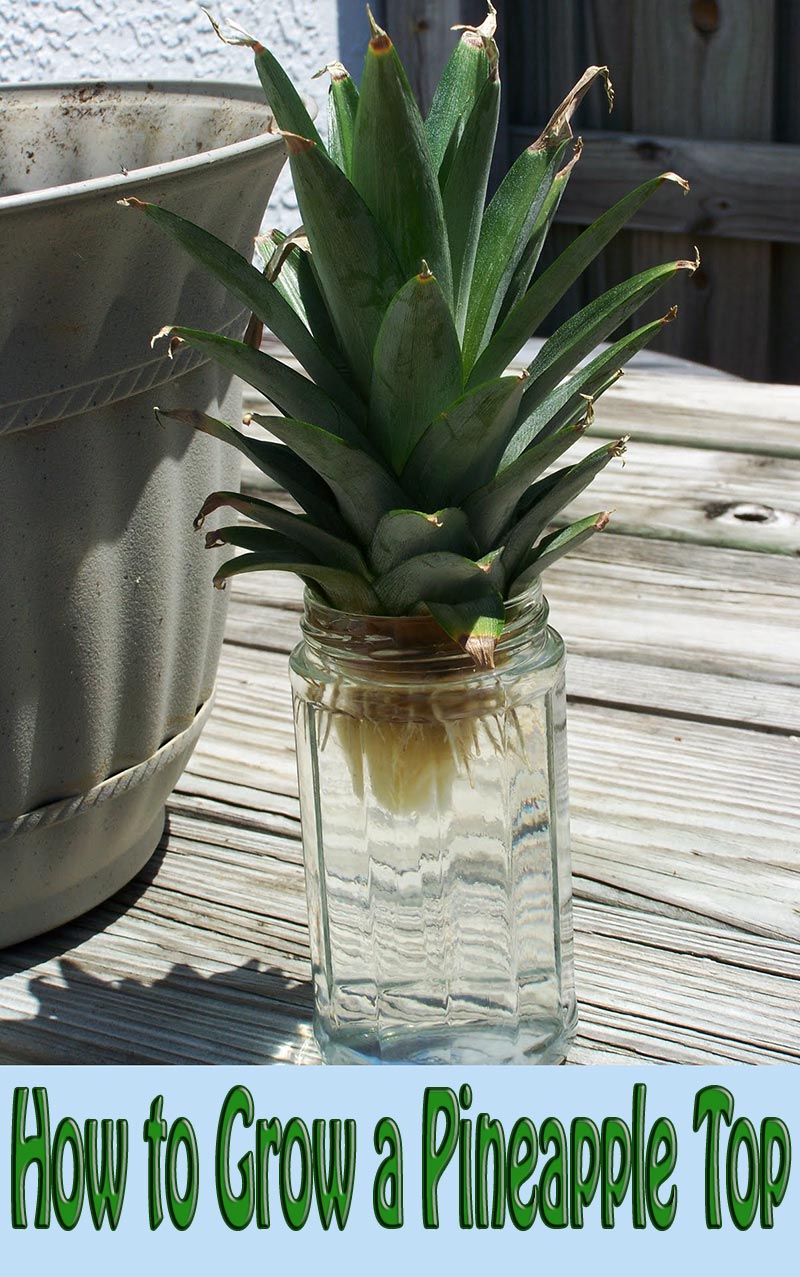
How to Grow a Pineapple Top
Rooting and growing pineapple top is easy. Did you know that the leafy top of store-bought pineapples can be rooted and grown as an interesting houseplant?
Pineapple is one of the world’s most unique and exotic tropical fruits, yet it is possible to grow it in a temperate zone under controlled conditions; with the most difficult part of the process just getting it rooted. Although you may not be able to grow as large a plant as is grown on a plantation in Hawaii, the following information should enable you to grow a healthy, attractive pineapple for your home. And it makes a fun family project for the kids!
With some patience, you can even grow a new pineapple from this plant. It takes about two to three years, though, and even then some plants are difficult to get to produce new fruit. However, I’ve searched the web and have provided below the best techniques for improving your odds of harvesting a ripe & delicious pineapple that will fill your house with its aroma.
To make full-sized pineapples, the plant will ultimately need to get about six feet across and six feet tall. But, you can grow it as an interesting indoor plant and even get it to produce fruit (albeit small fruit) without letting it take over the living room.
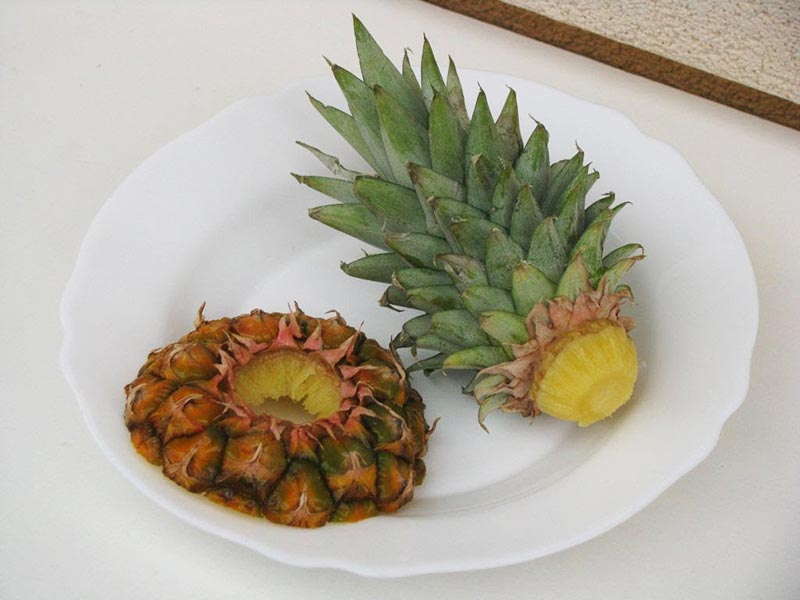
Here is some interesting trivia about your pineapple
The pineapple is a member of the bromeliad family. As such it is related to Spanish moss and some interesting ornamental plants sold in many nurseries. These ornamentals are interesting in that they absorb water and nutrients from a water-tight reservoir formed where the leaves come together.
Or by interesting absorptive hairs which cover the Spanish moss and similar bromeliads, allowing them to draw water and nutrients from the fog and dust in the air. The pineapple, however, uses its roots like houseplants with which you are familiar and should be easy to grow if you treat it like a normal houseplant that needs bright light.
There seems to be no definitive site given for the original discovery of pineapples in the new world. It is thought they may have originated in the northeastern area of South America, near what is now known today as Guiana. There are several different pineapples besides the grocery store variety. For example, an Ananas nana is one of the smallest, about eighteen inches tall and grows in a six-inch pot.
One of the showiest pineapples is Ananas bracteatus, tricolor. When mature it is about four to five feet in diameter and about the same height. It flushes a brilliant pink at the base of its white and green striped leaves. It also has pink recurved spines so caution must be exercised when working around the plant. Our commercial pineapple, Ananas cosmos, var. Smooth Cayene is the one most people are familiar with, but only in a can, as a fruit.
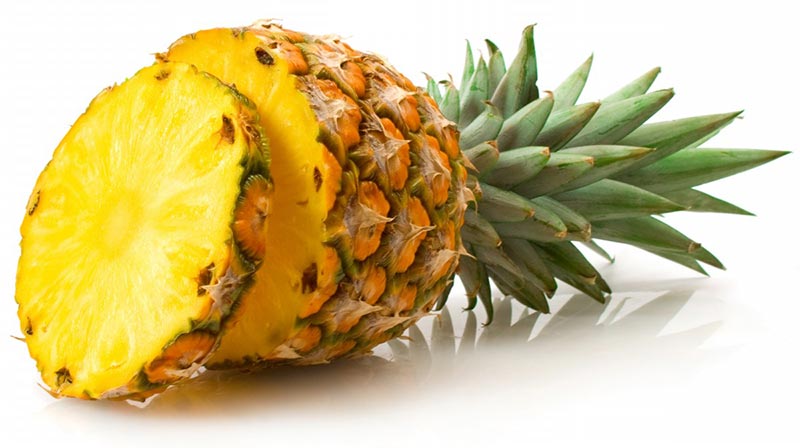
Obtain a Pineapple
From the local grocery store, choose a mature pineapple that has healthy, firm, green leaves (not yellow or brown) and with a fruit skin that is golden brown (not too green). Actually, I’d recommend growing two pineapples in the not unlikely event that one of them dies. At the very least you can pick the healthiest of the two plants to nurture to full growth. Also, if you find you have more pineapple than you can eat, just chop it up and freeze it. It tastes great!
Inspect the base of the leaves for small grayish spots which are scale insects. If these are found, the crown should be discarded and one selected which is free of these insects. Try to find one that is ripe but not overripe. Test for ripeness by gently pulling on a leaf. If it pops out with ease, the fruit is overripe.
Prepare the Crown
Grab hold of the entire top set of leaves. Twist hard and it will come out with a bit of stalk. (If you cut the top off you will need to remove all of the excess fruit flesh, otherwise it will only rot and may kill the whole plant). Any adhering flesh should be trimmed off its base to prevent rotting after planting.
After trimming, carefully slice small, horizontal sections from the bottom of the crown until you see root buds that appear as small dots or circles on the flat, cut surface. Remove as little tissue as possible to avoid cutting into young stem tissue.
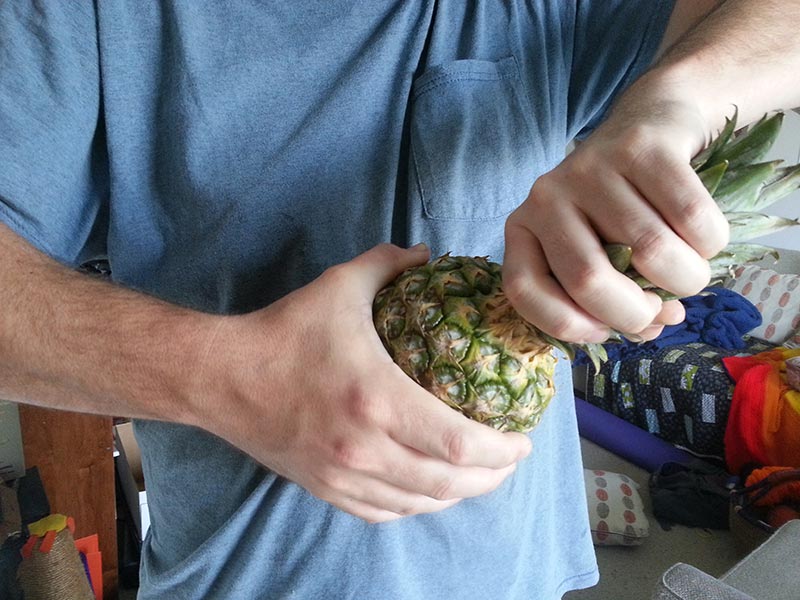
Next, strip off some of the lower leaves, exposing up to about an inch of the base of the crown. They will come off in sort of a spiral fashion. The idea is to bare the stalk. The small brown-colored bumps below the leaf scars are root primordia (baby roots waiting to grow) and there may even be a few short roots at the base of the crown . Though these won’t be the roots that will grow in the next step, try not to damage these.
After trimming and stripping, let the crown dry out for a couple days before going to the next step. This will permit the cut end and the leaf scars to heal and prevent rot.
Root the Crown
There are various ways to do this, but I have found after trying several methods, that the simplest is the most effective. Place the crown in a clear glass of water and change out the water every few days. Place the crown away from any temperature extremes (heating or cooling vents/hot south-facing windows). On top of the refrigerator will work. In three weeks you’ll see healthy root growth.
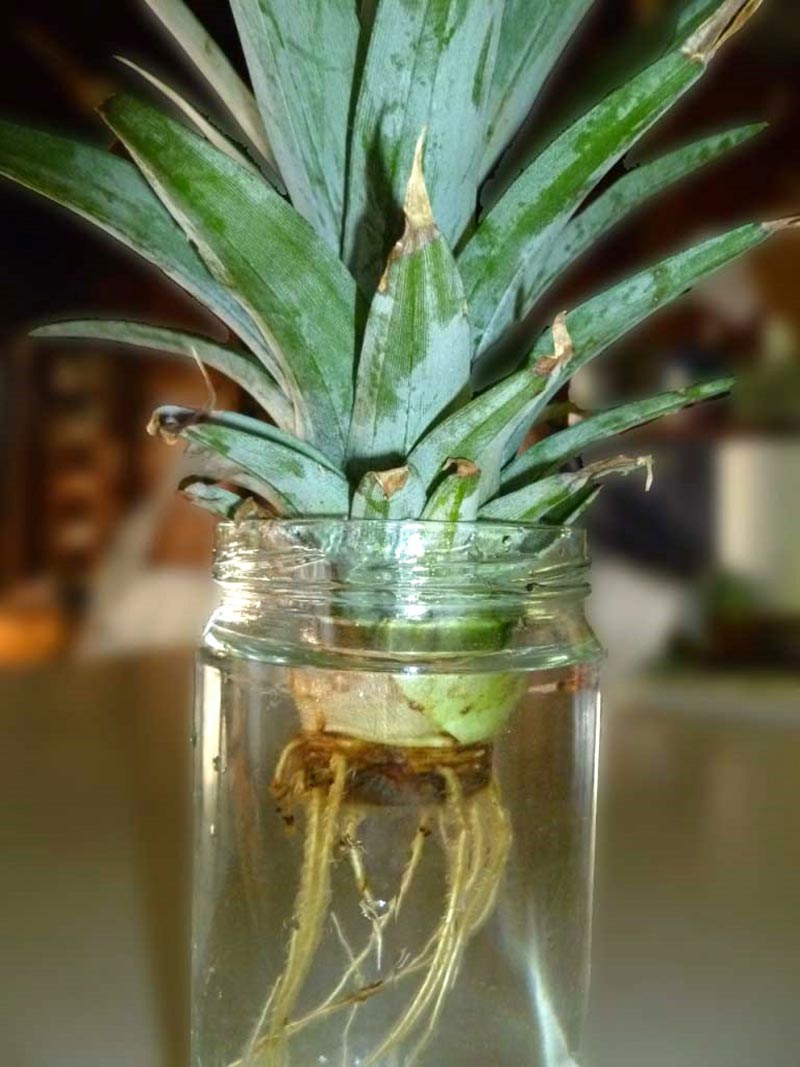
Plant the Crown
Once roots appear, plant the pineapple in a fast draining potting soil such as a Bromeliad or Cactus Potting Soil mixed with a third perlite. An eight-inch porous clay pot with bottom drainage is ideal. Layer about two inches of stones in the bottom of the pot prior to putting in the soil/perlite mix.
The first step is to cover the drainage hole with the pottery shard.
Second, put in a layer of stones followed by the soil and perlite mix. Finally, plant the crown and water it thoroughly prior to placing it in a window or some other sunny place.
In terms of watering, the soil should always be slightly moist; not wet (which will promote rot) and not dry. It will take six to eight weeks for the stalk to really start sending out strong roots. Do not rush this process or fertilize at this point.

After about two months, the pineapple should be supporting itself as a new plant. Gently tug on the plant to see if new roots have formed. If they are present, they will resist your tug. If absent, the top of the pineapple will pull from the soil revealing the absence of new roots. If there are no new roots, replace the pineapple top in the soil and wait longer. If the base looks like it is rotting, start again with a new pineapple top, root it again as above and then use fresh potting soil. Repeat the process, but be sure not to over water.
At this point you should notice that the original leaves of the pineapple will begin to die and turn brown, with new leaves beginning to grow at the center. Over the course of the following year, remove the original leaves as they die. During this time the pineapple should be watered no more than once a week.
If roots have developed with the new leaf growth, it is a sign that things are going well.
After one full year of growth, repot the plant.
My plants rooted indoors, however real growth didn’t begin until I took them outside in the spring. With the next growing season they’ll be repotted as instructed below. 3) grow two crowns as one will likely not be as strong as the other. Then you can repot the healthier one. You may also notice that I clipped the tips off of the plants as I think I left them outside too long, and the cold turned their tips brown.
Repot the Crown
Repot the pineapple in a twelve-inch porous clay pot with a well-draining potting soil such as a cactus potting soil. See the photos below of my 2 pineapple plants after their 2nd repotting. Be sure there is good drainage since pineapples do not like ‘wet feet’. Provide drainage by placing a curved piece of broken pot over the hole in the bottom of the pot. Over this, add about a half an inch of coarse gravel or small stones, and then add your soil up to an inch from the top, patting down the soil gently to firm it up.
Tamp the soil firmly around the base of the crown at planting. Avoid getting soil into the central leaves of the crown.
Rot is commonly caused by over watering or the soil not draining properly. The plant should only stop growing during the winter months. It will put out new growth all during the early spring and summer well into fall. If the plant stops growing during its growing season, take the plant out of the pot and examine the root structure carefully. They should be firm and solid. If necessary, wash off the old potting mix and repot into fresh mix.
As the pineapple continues to grow, you may need to repot it into an even larger pot if it gets root-bound.
General Care & Feeding
Light and temperature
A pineapple is a tropical plant and frost or freezing temperatures will kill it. If you live in a temperate climate, your pineapple must divide its time between your house and your porch or garden.
Pineapples like to get at least 6 hours of bright light each day. During summer, set your plant on a sunny porch or bury the pot in your garden. Do not take your plant out of the house until all danger of frost is past. When you first remove your plant from your house, keep it in a semi-shaded spot for several days to prevent sunburn.
During cold months, keep your plant in the house. Bring it in early in the fall, by mid-September. Place it near a window or sliding-glass door for maximum sunlight. At night, move it away from the window to prevent freezing. The pineapple prefers a temperature of 65 – 75 degrees F (minimum of 60 degrees). If the room is warm enough for you to be comfortable, the pineapple will be at the right temperature.
You can also grow your plant indoors, for example in a basement, by using “Plant-Gro” fluorescent light tubes. This light can also be helpful if your windows do not let enough sunshine into the room where you are keeping your plant. You should keep the light on for between 12 and 14 hours per day. When the plant gets large enough to bear a fruit you should reduce the day length to 10 to 11 hours until the inflorescence appears in the center of the plant. You can then return to longer days.
Watering and fertilizing
The pineapple plant is miserly with water, requiring only about 20 inches of natural rainfall per year, if well distributed. You need only wet the soil once a week, and when the plant is indoors, it is best to apply all the water to the soil. When outside, spray the leaves in addition to wetting the soil so that the cups at the bottom of the plant are filled. It is also important that it never completely dries out. Then again, it must never sit in soggy soil. During its growing season, it will appreciate more water than in the winter months.
Fertilize carefully and only about once every month or so during the growing season. If using a solid plant food, scatter it on the surface of the soil and wash it in by watering.
A liquid (foliar spray) fertilizer can also be used. Pour the solution into the base of the leaves and on the surface of the soil. Take special care not to pour the solution into the center of the plant as the young leaves may be injured. Follow directions under “small shrubs” given on the label of the products you use.
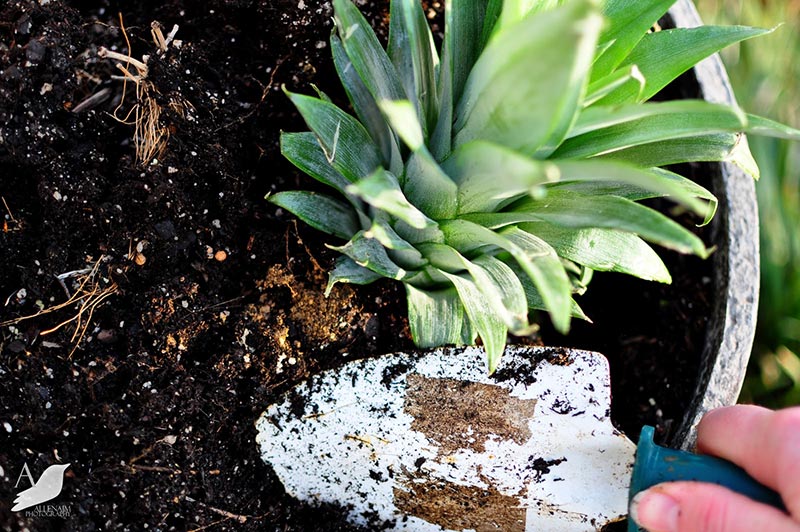
Pests and diseases
As house plants, your pineapple will be subject to a minimum of pests and diseases if given proper care. The pests most likely to attack your plant are mealy bugs, scale and mites. All can be removed by washing the leaves with soapy water, rinsing after with clear water. Or, spray with an insecticide. Be sure to follow the directions on the label when using insecticides.
The only disease you would likely encounter would be heart rot caused by fungi. In heart rot, the central leaves turn black and are easily pulled out of the plant. When heart rot occurs, the plant can sometimes be saved by pouring a fungicide into the heart (center) of the plant. If this stops the infection, a side shoot will start growing. This shoot will then become your plant and will eventually flower and form a fruit. Or you can remove it and begin a new plant.
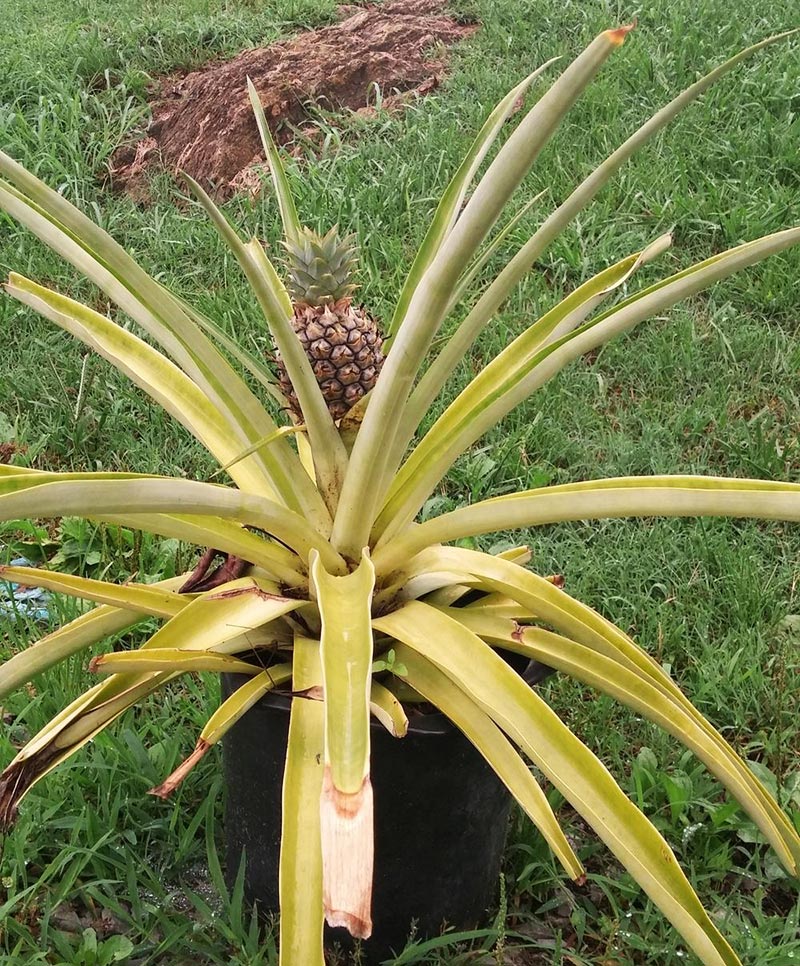
Flowering and Fruiting
Although the pineapple plant is attractive in and of itself, most growers want their plants to flower and fruit. In Hawaii, a crown takes about twenty to twenty-six months to produce a ripe fruit. However, it may only take twenty months, and you will see some surprises along the way. When your plant is at least 24 inches tall and twelve to fourteen months old, an inflorescence bud will begin to form in the center of the leaves. You will not be able to see the developing fruit until about two months later when it will surprise you with a bright red cone emerges from its center.
After twenty months come the flowers. Bright blue flowers open row by row, starting at the bottom, over about two weeks (flower development in Hawaii typically occurs in late December or January when the days are short (about 10.5 hours) and the nights are cool (55 to 65 F; about 13 to 18 C)). Each flower only lasts one day, but there are many to enjoy.
When the petals of the last flower have dried, the fruit begins to develop. After three to six months from this period, your fruit will begin to ripen. When the fruit is golden halfway up, your pineapple is ready. Surprisingly enough it will be just about the size of a can of pineapple, or a bit larger.
If your pineapple plant is at least 24 inches tall and has not flowered by the time it is twenty to twenty-four months old, you can “force” it with a few different techniques that trick the plant into putting its energy into flowering instead of making new leaves.
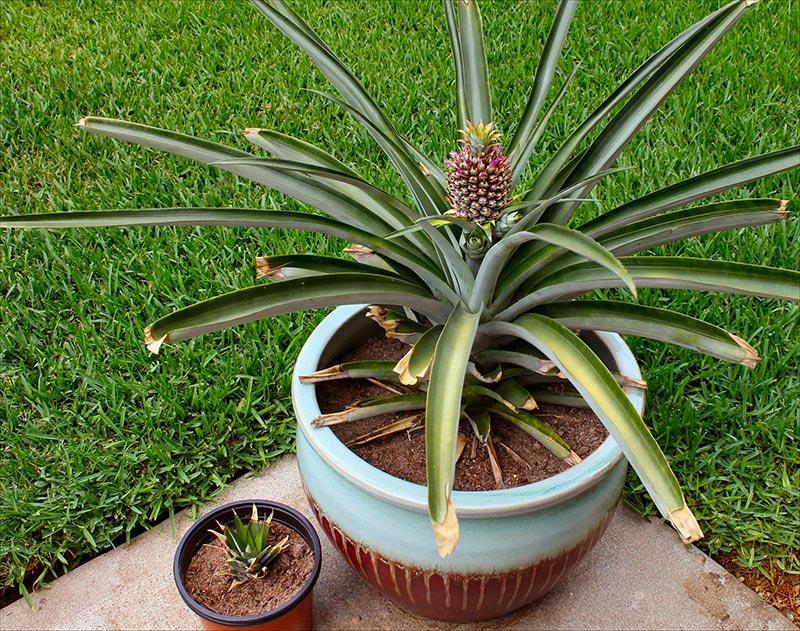
Forced Fruiting
It is best to force the plant to flower during the winter months when the days are cooler and shorter as this is when a pineapple is accustomed to making fruit.
The first technique is to lay the plant and pot on its side between waterings. This interferes with hormones in the plant, causing the production of another hormone, ethylene, which induces flowering.
A second method of inducing flowering is to place the plant in a bag with two ripe & bruised apples for two weeks. Move the plant to a shady location during this time, and then move it back to its sunny spot. The ripening apples produce ethylene gas that will induce flowering in the pineapple.
A third method is to place a small lump of calcium carbide about the size of your little fingernail in the center of your plant and pour a quarter cup of water over it. This will release acetylene gas that will force your plant to flower. To improve your chances of success, it is best to treat your plant in the evening after the sun goes down and temperatures are cooler. (Calcium carbide may be obtainable at a welding shop, garden store, pharmacy or toy store.)
Two to three months later, the plant should form a flower spike in its center.
Harvesting your pineapple
When your fruit is about six months old, about four months after flowering has occurred, changes begin to occur. The color of the shell changes from green to rich gold. The color change of the shell occurs first at the bottom of the fruit and moves upwards.
During this change, the fruit becomes sweeter and the color of the flesh changes from white to yellow. The fruit will weigh from two to four pounds. When the fruit is golden half way up it can be picked and eaten, though if you wait until it’s fully ripe it will be worth the wait! Once the fruit develops, it should last on the plant for several months.
Here is another way of growing pineapples
Learn how to grow a pineapple plant from a grocery store bought pineapple. Also includes info on how to water the plant and force it to flower! See the video below!
Please follow us on Facebook Page and enjoy our collection of recipes, crafts, fitness, health tips, gardening, DIY and more…
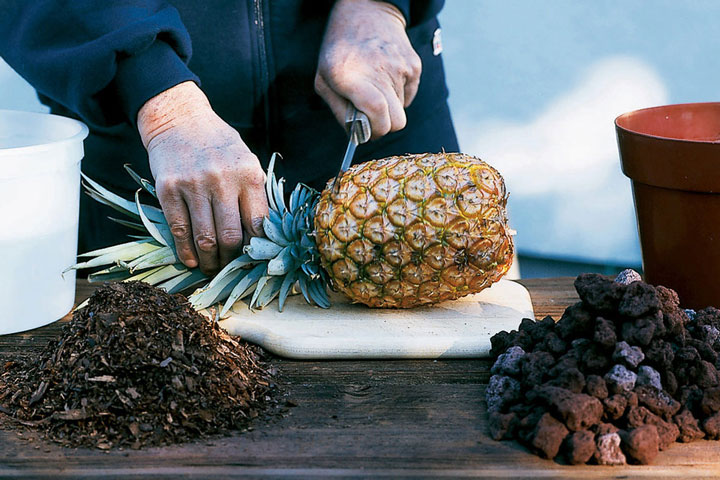


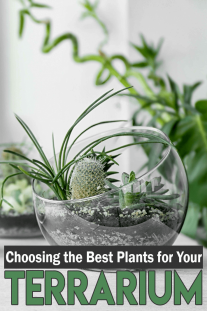
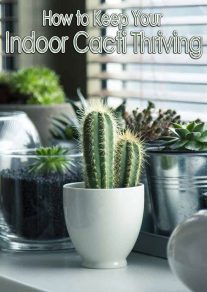
Leave a Reply